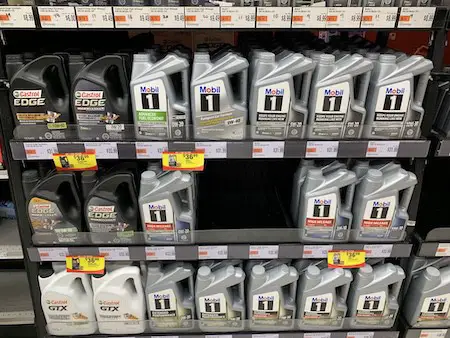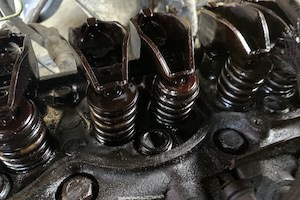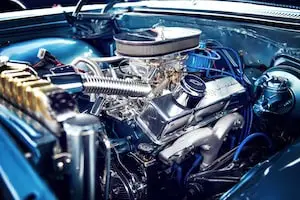There is mystery, rumors and controversy around what oil can and cant be used in your car, what happens if they are mixed, and if they are changed. The best way to answer the question is to provide all of the key information to understand engine oil condensed into this simple 5 minute read.
What happens if I put 5W-20 instead of 5W-30 in my engine if the engine recommends 5W-30?
Using 5W-20 instead of 5W-30 oil is a fine substitute, will not cause damage to your engine, and will not have a noticeable difference. The main difference is 5W-20 is thinner than 5W-30 at high temperatures. 5W-20 and 5W-30 are similar enough oils they can be mixed and interchanged although it is recommended to use what the car manufacturer specifies and to not mix oils.
To understand why this is it is best to know things like what the numbers of the oil ratings mean.
5W-20 Instead of 5W-30
It is recommend to select an oil from a range of oil weights to use in your car depending on the temperatures of the environment the car is in. Changing the oil weight by one increment with either the cold weight or the warm weight can actually be beneficial for the engine!
Car manufacturers provide a range of acceptable oil weights to use and these two weights are similar enough to use unless specified otherwise by the car manufacturer. In general, it is acceptable to substitute or combine oils close in classifications although it is recommended to use what the manufacturer recommends.
The main difference between 5W-20 and 5W-30 is 5W-30 acts like a thicker oil at high operating temperatures. If the car manufacturer recommends 5W-30 and 5W-20 is used, then the car should not be run to extremely high temperatures or in and environment where it is extremely hot.
To better understand why, let’s go over first what the oil rating numbers mean and what oil weight is.
Understanding Oil Weight
The cold weight of the oil is the number before the letter “W”.
This number describes how thick the oil is at 0 degrees Celcuis (32 degrees F)
The warm weight of the oil is the number after the hyphen “-“.
This number describes how thick the oil is at 100 degrees Celcuis (212 degrees F)
What the Engine Oil Numbers Mean
The numbers used to label engine oils indicate the viscosity of the oil.
Viscosity means “thickness”.
Higher viscosity = THICKER.
Lower viscosity = Thinner.
A lower number of the engine oil weight means thinner and a higher number means thicker.
Okay well theres the fundamentals of the engine oil numbers, but great. Now what numbers do I want on my engine oil to have a flawlessly running machine?
Multi-Weight Oil Is Most Common in Cars
Multiweight oil is what is used widely for street cars because it provides an oil that can be thin at startup to move quickly throughout the engine even when colds but also thick enough to be able to thin out to the right consistency when hot.
Oils that are marked with a ##W-## is a multi-weight oil.
An oil that is not multi-weight would be labeled something like SAE30 or SAE40 and would be called a 30 weight or 40 weight oil respectively.
Straight weight oil is used for engines other than cars and has its own advantages. Check out my other article about the advantages of straight-weight oil if you are curious.

What Engine Oil Does
Understanding the function and purpose of oil will better aid in understanding why using the wrong oil or dirty oil can cause serious damage.
A car engine needs lubrication to stay cool. The engine oil is required to reduce friction between the extremely fast moving parts in the engine. Without the lubrication of engine oil, the engine would only last a couple minutes before overheating, the metal expanding, and parts failing.
An oil that is thick enough to provide adequate lubrication but not too thick to cause high friction is essential.
Oil thins as temperature rises and as it gets hot and thin it has less ability to lubricate and cool.
Thinner engine oil that is still adequate for lubrication results in better fuel efficiency because the engine parts will have less resistance.
If the oil is too thin, it will have decreased ability to lubricate and the engine can run hot.
If the oil is too thick, it will have a hard time circulating. Especially when cold and during cold starts is one of the more critical times that the engine needs oil to lubricate and prevent wear.
When 5W-20 is Not a Good Substitute for 5W-30
If the car manufacturers specify otherwise.
It is a relatively easy thing to take a look in your car manual and determine what oil is recommended and in the same place you will find either a list of other oils that will work just as well, or a recommendation to use nothing but a certain oil.
This is the best practice and what is recommended.
5W-20 is not a good substitute for 5W-30 if:
- The engine already runs hot or if the car is in an extremely hot environment.
- The engine makes a knocking/tapping sound after adding it.
- The car manufacturer recommends against using it.
Why Are There Different Oil Weights?
With such a variety of engines off all sizes and materials and specifications, a variety of engine oils is needed in different engines. Engine manufacturers have tested various engine oil weights and have determined an oil that works optimally to lubricate and result in the least amount of wear on an engine. The recommended oil weight is the simplest solution and the safest easiest choice because it has been tried and tested.
Changing the engine oil that you put in your engine may have adverse affects on the engine. Do not venture too far from the recommended engine oil although there is some flexibility and a variety of oils may work just as well as others.
By labeling engine oil weights with different numbers, oil makers have made it easy for us to interpret the application of the oil.
A lower number before the “W” will work better in colder temperatures because it is thinner.
A higher number after the hyphen “-” will work better at high temperatures.
Again this is all to some extent. Keep it close to the recommended oil weight an you’ll be fine.
Oil must be thick enough when cold to still be thick enough when hot to properly lubricate the engine.
Oil must be thin enough when cold to quickly move throughout the engine for start-up lubrication.
If you are looking for a deeper dive into oil viscocities and what is really happening, check out Machinery Lubrication’s article that explains more in detail overall viscocity changes and kinematic viscocity.
Conclusion
5w-20 can be added to 5W-30 or substituted and likewise 5W-30 can be added to 5W-20 or substituted. The two oils are very similar in behavior and can be added with no consequence unless specified by the car manufacturer.
Engine oils can be interchanged within reason and can be mixed together but pay attention to how the car reacts. Any new clicking or knocking noise means you better change it right back because it can be a bad thing to substitute or add depending on the type of car and the amount of wear on the engine.
All of these things are possibility but our recommendation and the best thing to do is to use whatever the car manufacturer specifies!


